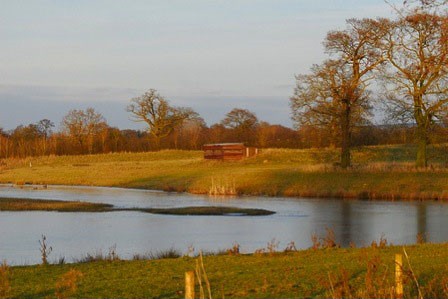Marsh Lane Nature Reserve - Berkswell Quarry
Working with the landowners, Packington Estates and Natural England, CEMEX UK has transformed former sand and gravel pits at Berkswell Quarry in the UK's Midlands into a 22-hectare nature reserve. Marsh Lane Nature Reserve attracts a variety of rare birds and is an important conservation area for the local community.

Bird-viewing hide over the lake at Marsh Lane Nature Reserve
Rare species found at Marsh Lakes Nature Reserve:
- Golden plover
- Black kites
- Little egrets
"The area used to be agricultural land and was quarried for sand and gravel. We were left with a hole in the ground which we had to do something with. We felt a conservation area was a good thing to do with it. It is on green belt so housing or industrial development wasn't going to be an option but we felt conservation was important." Nicholas Barlow, Estate Manager at Marsh Lane Nature Reserve.
CEMEX relies on raw materials such as limestone, sand, gravel and clay to make its cement and concrete products. These are essential for building the roads, schools and homes that society needs, but quarrying the materials has the potential to degrade habitats and damage species unless the land is carefully managed. We are determined to have a positive impact on nature by promoting a diverse range of habitats and species while quarries are active, and by rehabilitating disused sites. By restoring former quarry sites we also provide communities with new nature reserves and education and leisure facilities.
The extraction of sand and gravel from the Berkswell Quarry between Solihull and Coventry began in 1995 and ended in 1999. CEMEX UK worked with the landowners to rehabilitate the site when quarrying ceased. We finished this work in 2001 and opened the restored site, known as Marsh Lane Nature Reserve, to the public. The reserve lies in the floodplain of the River Blythe, a Site of Special Scientific Interest (SSSI) and is split by the former old Kenilworth Road, which is now a footpath.
CEMEX UK worked with the site owners and Estate Manager to establish the nature reserve. We rehabilitated the area over a two-year period, creating three main pools. The reserve also has a woodland area, grassland, ponds and some agricultural land.
We reshaped two of the main pools to include a number of islands, which attract a range of breeding and passing wading birds. We set aside a five-acre field to provide food and cover for finches and buntings and, in winter, over 100 yellowhammers, 60 reed buntings and 300 linnets flock to the area.
In 2010, Natural England helped us to shape a further 16 acres of former farmland at the site into wet grassland. This provides extra feeding and breeding habitat for waders.
The site owners wanted the community to benefit from the land and to encourage visitors. We constructed four hides to give excellent views of the pools and islands, and two further hides which overlook the wet grassland area. These two hides are linked by several pathways through the 13-acre Siden Hill Wood.
Marsh Lane Nature Reserve is one of the best sites in the West Midlands for bird watching. By March 2011, as many as 192 bird species had been observed at the site, including spotted sandpiper, grey phalarope and black kite. Every year, little egrets are found in the nature reserve and in winter up to 400 wigeon, 850 golden plover and 1000 lapwing are regular visitors.
With help from experts at the Royal Society for the Protection of Birds (RSPB), we have developed an ambitious ten-year biodiversity strategy. This sets challenging targets, including our goal to create and maintain, by 2020, 1,000 hectares of habitats identified by the UK Government as conservation priorities.
For more information please contact us.
